Australian Catholic University: BIOL122 Asthma Case Study
VerifiedAdded on 2023/01/12
|9
|699
|75
Practical Assignment
AI Summary
This assignment presents a case study of Mr. Bill, a 52-year-old male diagnosed with asthma. The study details Mr. Bill's personal information, medical history, including his mother's asthma diagnosis, and current symptoms such as chest tightness, breathlessness, and coughing. It explores the pathophysiology of asthma, focusing on bronchial smooth muscle contraction and increased mucus production. The assignment also covers prescribed medications, specifically salbutamol, its mechanism of action as a beta 2 adreno-receptor agonist, and its administration methods. Recommendations include treatment strategies like inhaled corticosteroids with beta 2 agonists and nursing interventions such as monitoring breathing rates. References from research papers on asthma management are also provided.

ASTHMA- CASE STUDY OF MR.
BILL
Name of the Student:
Name of the University:
BILL
Name of the Student:
Name of the University:
Paraphrase This Document
Need a fresh take? Get an instant paraphrase of this document with our AI Paraphraser
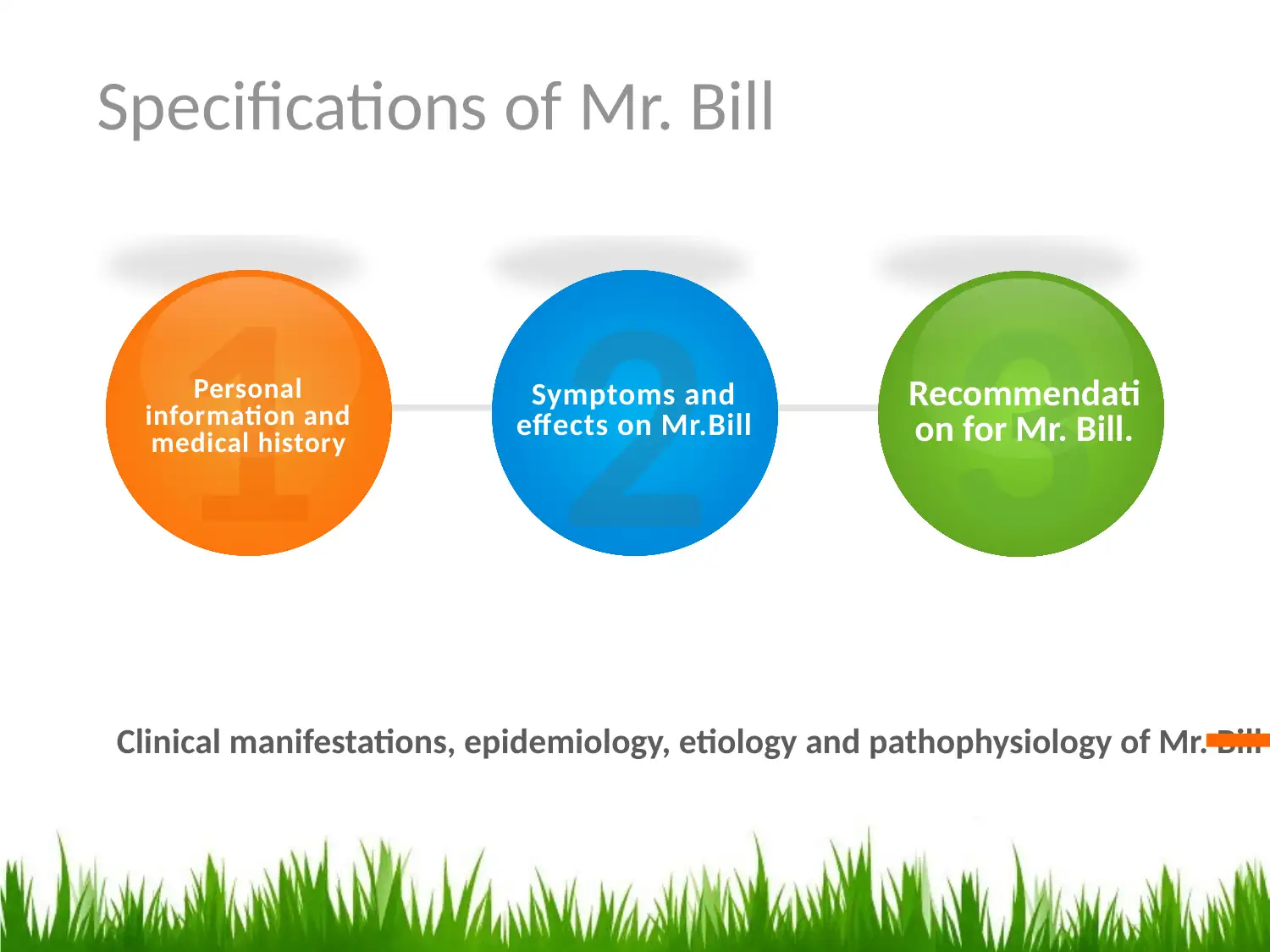
Specifications of Mr. Bill
Clinical manifestations, epidemiology, etiology and pathophysiology of Mr. Bill1
Personal
information and
medical history2
Symptoms and
effects on Mr.Bill3 Recommendati
on for Mr. Bill.
Clinical manifestations, epidemiology, etiology and pathophysiology of Mr. Bill1
Personal
information and
medical history2
Symptoms and
effects on Mr.Bill3 Recommendati
on for Mr. Bill.
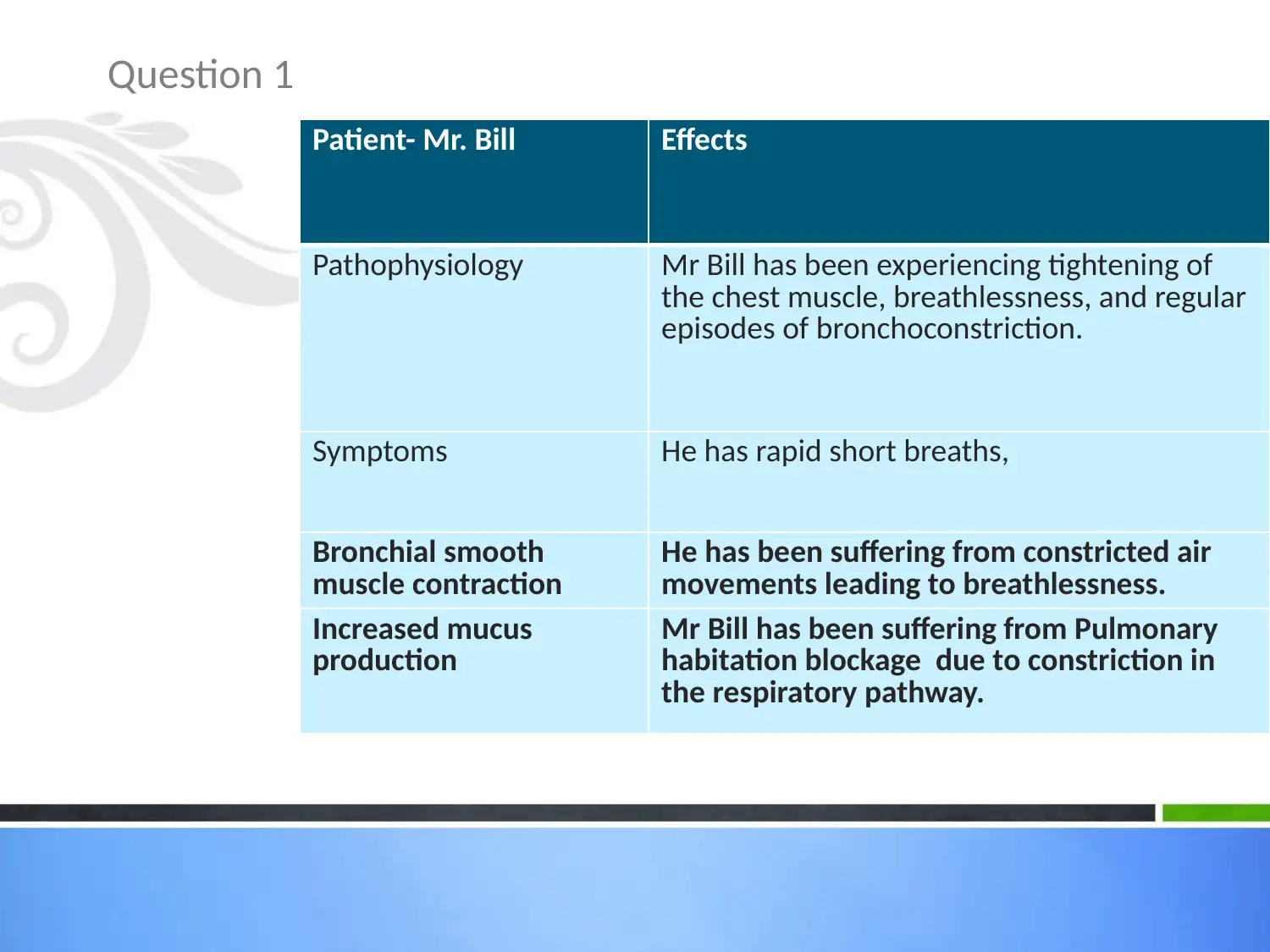
Question 1
Patient- Mr. Bill Effects
Pathophysiology Mr Bill has been experiencing tightening of
the chest muscle, breathlessness, and regular
episodes of bronchoconstriction.
Symptoms He has rapid short breaths,
Bronchial smooth
muscle contraction
He has been suffering from constricted air
movements leading to breathlessness.
Increased mucus
production
Mr Bill has been suffering from Pulmonary
habitation blockage due to constriction in
the respiratory pathway.
Patient- Mr. Bill Effects
Pathophysiology Mr Bill has been experiencing tightening of
the chest muscle, breathlessness, and regular
episodes of bronchoconstriction.
Symptoms He has rapid short breaths,
Bronchial smooth
muscle contraction
He has been suffering from constricted air
movements leading to breathlessness.
Increased mucus
production
Mr Bill has been suffering from Pulmonary
habitation blockage due to constriction in
the respiratory pathway.
⊘ This is a preview!⊘
Do you want full access?
Subscribe today to unlock all pages.

Trusted by 1+ million students worldwide
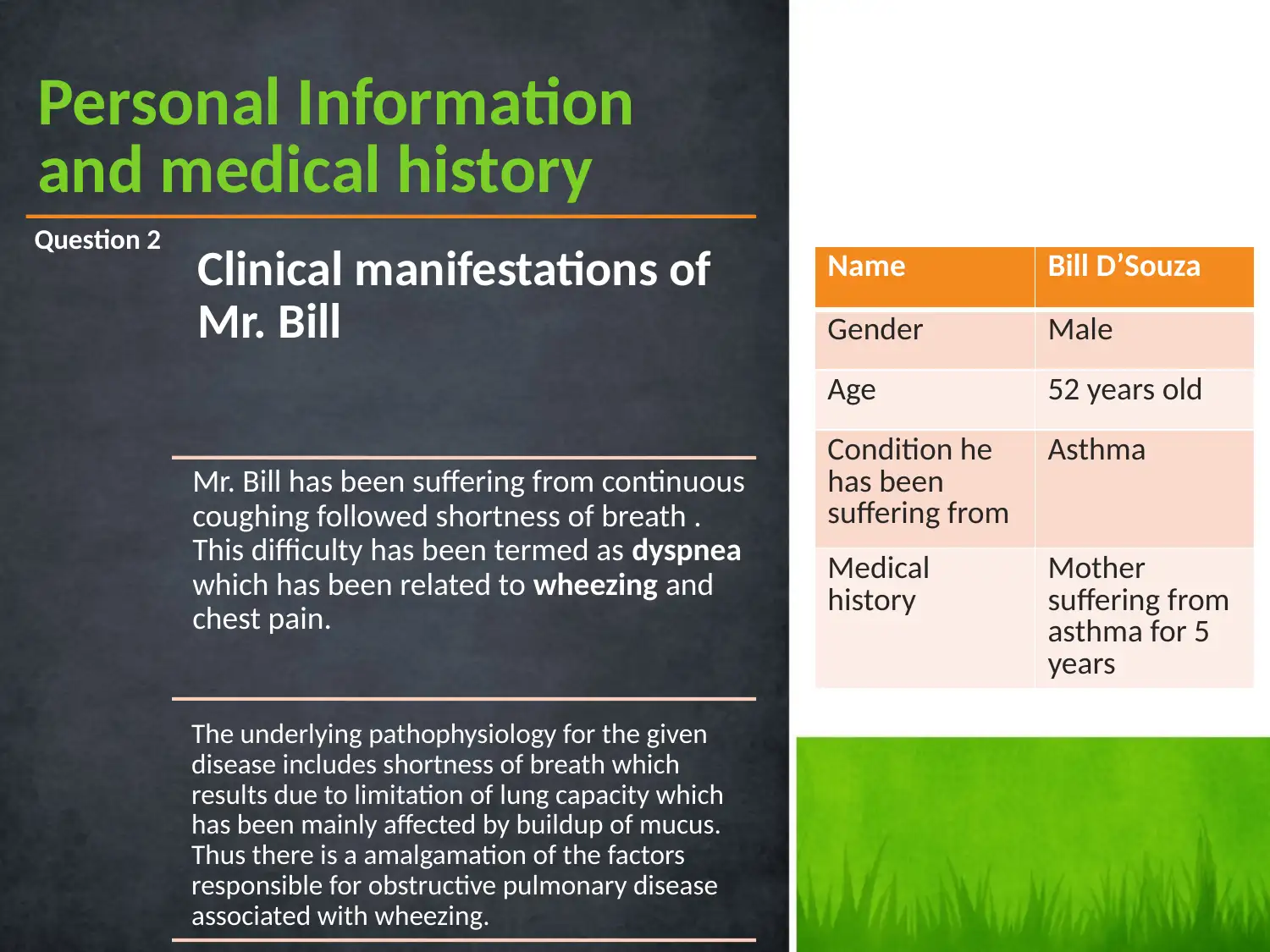
Personal Information
and medical history
Name Bill D’Souza
Gender Male
Age 52 years old
Condition he
has been
suffering from
Asthma
Medical
history
Mother
suffering from
asthma for 5
years
Question 2
Clinical manifestations of
Mr. Bill
Mr. Bill has been suffering from continuous
coughing followed shortness of breath .
This difficulty has been termed as dyspnea
which has been related to wheezing and
chest pain.
The underlying pathophysiology for the given
disease includes shortness of breath which
results due to limitation of lung capacity which
has been mainly affected by buildup of mucus.
Thus there is a amalgamation of the factors
responsible for obstructive pulmonary disease
associated with wheezing.
and medical history
Name Bill D’Souza
Gender Male
Age 52 years old
Condition he
has been
suffering from
Asthma
Medical
history
Mother
suffering from
asthma for 5
years
Question 2
Clinical manifestations of
Mr. Bill
Mr. Bill has been suffering from continuous
coughing followed shortness of breath .
This difficulty has been termed as dyspnea
which has been related to wheezing and
chest pain.
The underlying pathophysiology for the given
disease includes shortness of breath which
results due to limitation of lung capacity which
has been mainly affected by buildup of mucus.
Thus there is a amalgamation of the factors
responsible for obstructive pulmonary disease
associated with wheezing.
Paraphrase This Document
Need a fresh take? Get an instant paraphrase of this document with our AI Paraphraser
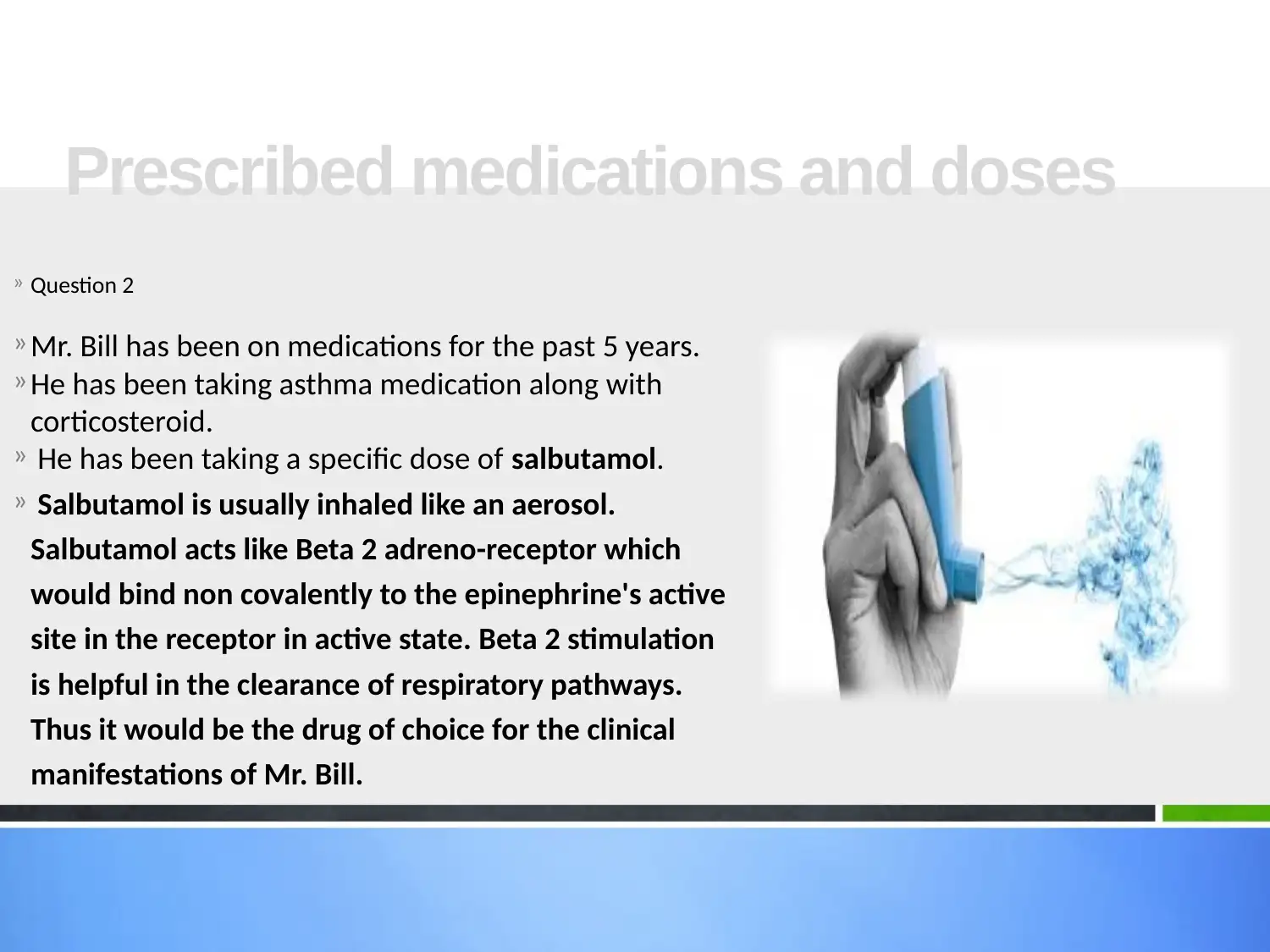
» Question 2
»Mr. Bill has been on medications for the past 5 years.
»He has been taking asthma medication along with
corticosteroid.
» He has been taking a specific dose of salbutamol.
» Salbutamol is usually inhaled like an aerosol.
Salbutamol acts like Beta 2 adreno-receptor which
would bind non covalently to the epinephrine's active
site in the receptor in active state. Beta 2 stimulation
is helpful in the clearance of respiratory pathways.
Thus it would be the drug of choice for the clinical
manifestations of Mr. Bill.
Prescribed medications and doses
»Mr. Bill has been on medications for the past 5 years.
»He has been taking asthma medication along with
corticosteroid.
» He has been taking a specific dose of salbutamol.
» Salbutamol is usually inhaled like an aerosol.
Salbutamol acts like Beta 2 adreno-receptor which
would bind non covalently to the epinephrine's active
site in the receptor in active state. Beta 2 stimulation
is helpful in the clearance of respiratory pathways.
Thus it would be the drug of choice for the clinical
manifestations of Mr. Bill.
Prescribed medications and doses
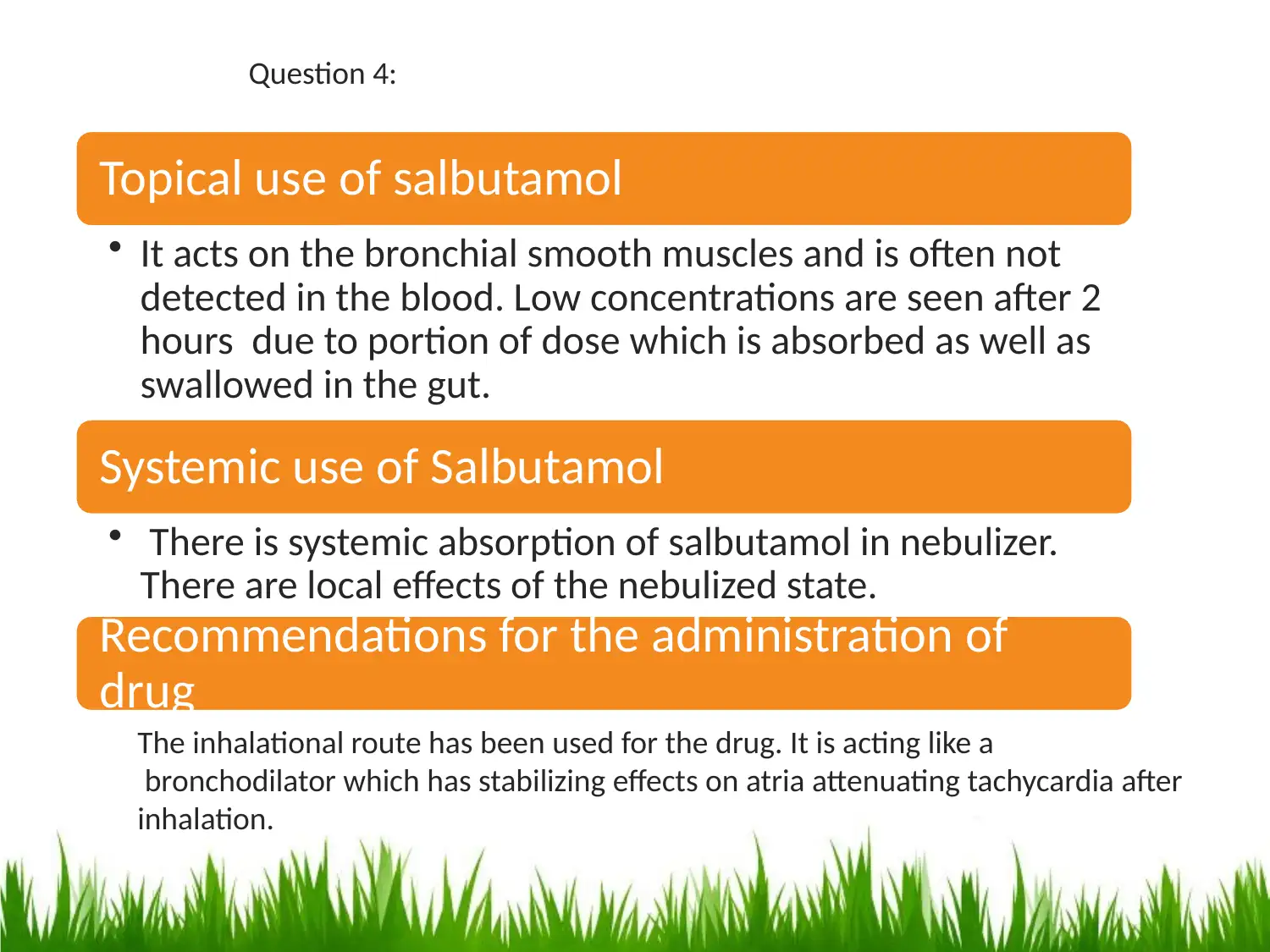
Topical use of salbutamol
• It acts on the bronchial smooth muscles and is often not
detected in the blood. Low concentrations are seen after 2
hours due to portion of dose which is absorbed as well as
swallowed in the gut.
Systemic use of Salbutamol
• There is systemic absorption of salbutamol in nebulizer.
There are local effects of the nebulized state.
Recommendations for the administration of
drug
Question 4:
The inhalational route has been used for the drug. It is acting like a
bronchodilator which has stabilizing effects on atria attenuating tachycardia after
inhalation.
• It acts on the bronchial smooth muscles and is often not
detected in the blood. Low concentrations are seen after 2
hours due to portion of dose which is absorbed as well as
swallowed in the gut.
Systemic use of Salbutamol
• There is systemic absorption of salbutamol in nebulizer.
There are local effects of the nebulized state.
Recommendations for the administration of
drug
Question 4:
The inhalational route has been used for the drug. It is acting like a
bronchodilator which has stabilizing effects on atria attenuating tachycardia after
inhalation.
⊘ This is a preview!⊘
Do you want full access?
Subscribe today to unlock all pages.

Trusted by 1+ million students worldwide
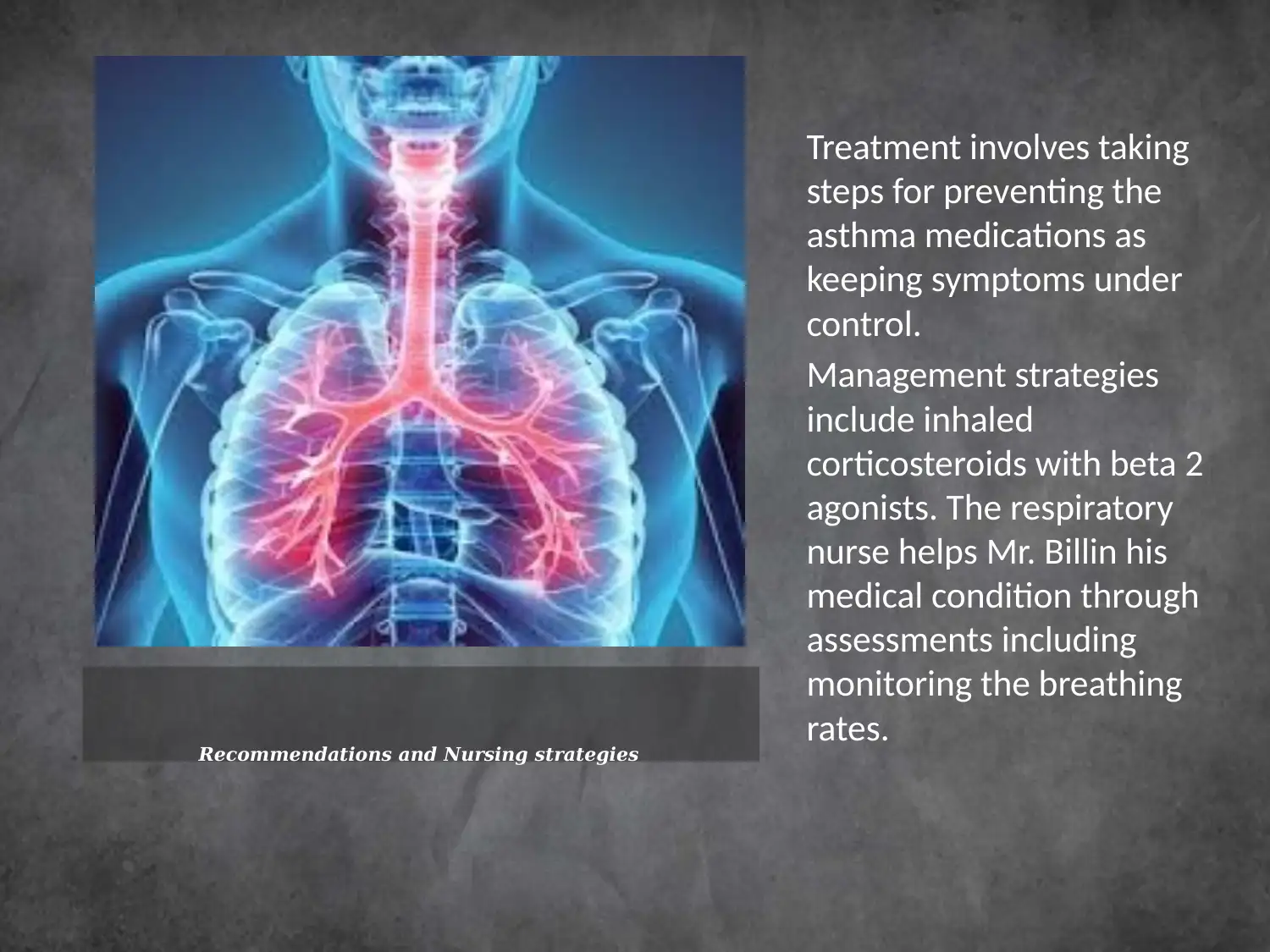
Recommendations and Nursing strategies
Treatment involves taking
steps for preventing the
asthma medications as
keeping symptoms under
control.
Management strategies
include inhaled
corticosteroids with beta 2
agonists. The respiratory
nurse helps Mr. Billin his
medical condition through
assessments including
monitoring the breathing
rates.
Treatment involves taking
steps for preventing the
asthma medications as
keeping symptoms under
control.
Management strategies
include inhaled
corticosteroids with beta 2
agonists. The respiratory
nurse helps Mr. Billin his
medical condition through
assessments including
monitoring the breathing
rates.
Paraphrase This Document
Need a fresh take? Get an instant paraphrase of this document with our AI Paraphraser
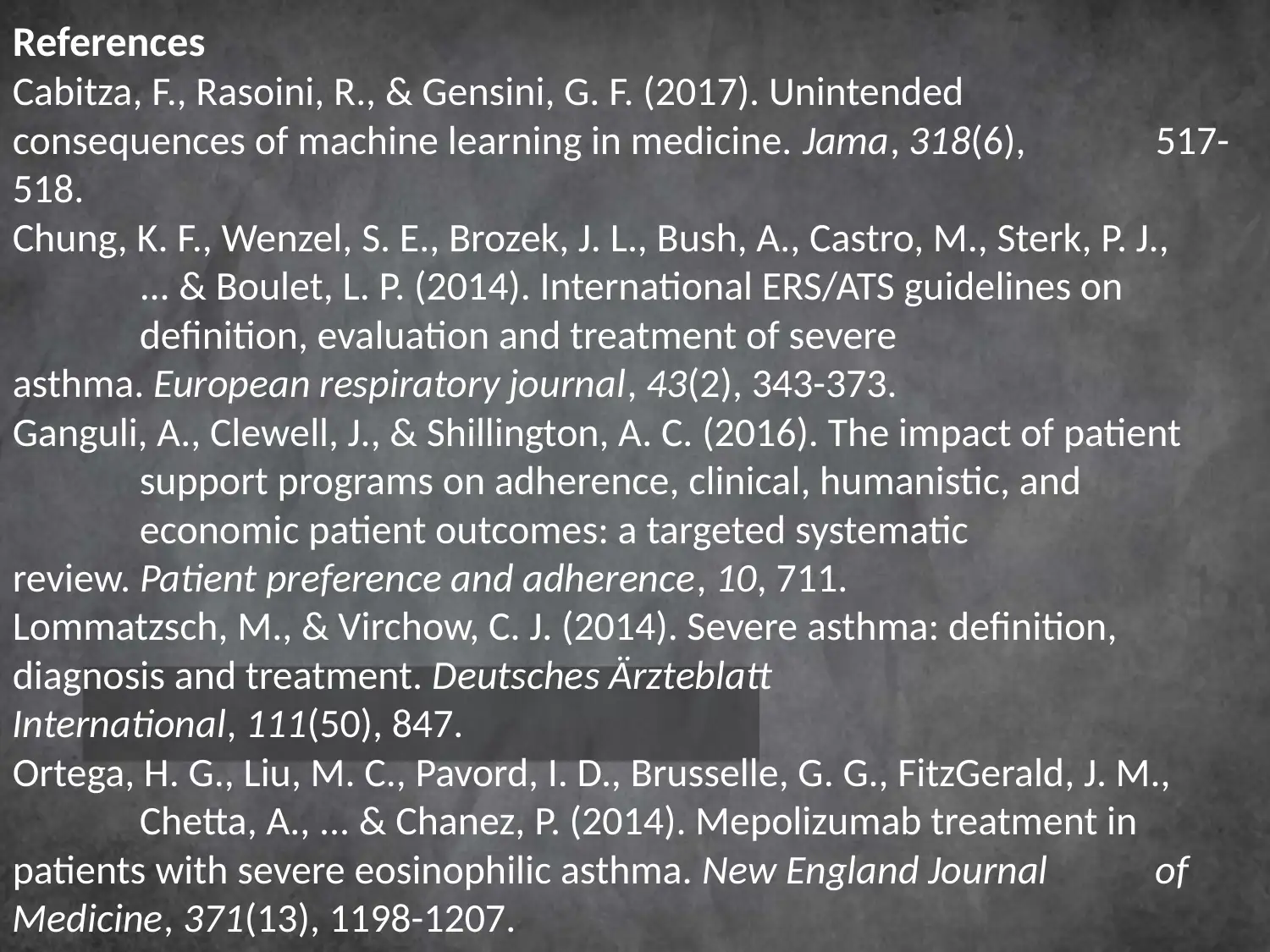
References
Cabitza, F., Rasoini, R., & Gensini, G. F. (2017). Unintended
consequences of machine learning in medicine. Jama, 318(6), 517-
518.
Chung, K. F., Wenzel, S. E., Brozek, J. L., Bush, A., Castro, M., Sterk, P. J.,
... & Boulet, L. P. (2014). International ERS/ATS guidelines on
definition, evaluation and treatment of severe
asthma. European respiratory journal, 43(2), 343-373.
Ganguli, A., Clewell, J., & Shillington, A. C. (2016). The impact of patient
support programs on adherence, clinical, humanistic, and
economic patient outcomes: a targeted systematic
review. Patient preference and adherence, 10, 711.
Lommatzsch, M., & Virchow, C. J. (2014). Severe asthma: definition,
diagnosis and treatment. Deutsches Ärzteblatt
International, 111(50), 847.
Ortega, H. G., Liu, M. C., Pavord, I. D., Brusselle, G. G., FitzGerald, J. M.,
Chetta, A., ... & Chanez, P. (2014). Mepolizumab treatment in
patients with severe eosinophilic asthma. New England Journal of
Medicine, 371(13), 1198-1207.
Cabitza, F., Rasoini, R., & Gensini, G. F. (2017). Unintended
consequences of machine learning in medicine. Jama, 318(6), 517-
518.
Chung, K. F., Wenzel, S. E., Brozek, J. L., Bush, A., Castro, M., Sterk, P. J.,
... & Boulet, L. P. (2014). International ERS/ATS guidelines on
definition, evaluation and treatment of severe
asthma. European respiratory journal, 43(2), 343-373.
Ganguli, A., Clewell, J., & Shillington, A. C. (2016). The impact of patient
support programs on adherence, clinical, humanistic, and
economic patient outcomes: a targeted systematic
review. Patient preference and adherence, 10, 711.
Lommatzsch, M., & Virchow, C. J. (2014). Severe asthma: definition,
diagnosis and treatment. Deutsches Ärzteblatt
International, 111(50), 847.
Ortega, H. G., Liu, M. C., Pavord, I. D., Brusselle, G. G., FitzGerald, J. M.,
Chetta, A., ... & Chanez, P. (2014). Mepolizumab treatment in
patients with severe eosinophilic asthma. New England Journal of
Medicine, 371(13), 1198-1207.

? THANK
YOU
YOU
⊘ This is a preview!⊘
Do you want full access?
Subscribe today to unlock all pages.

Trusted by 1+ million students worldwide
1 out of 9
Related Documents
Your All-in-One AI-Powered Toolkit for Academic Success.
+13062052269
info@desklib.com
Available 24*7 on WhatsApp / Email
![[object Object]](/_next/static/media/star-bottom.7253800d.svg)
Unlock your academic potential
Copyright © 2020–2025 A2Z Services. All Rights Reserved. Developed and managed by ZUCOL.





